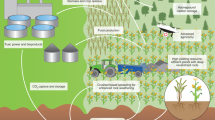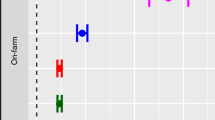Abstract
A doubling in global food demand projected for the next 50 years poses huge challenges for the sustainability both of food production and of terrestrial and aquatic ecosystems and the services they provide to society. Agriculturalists are the principal managers of global useable lands and will shape, perhaps irreversibly, the surface of the Earth in the coming decades. New incentives and policies for ensuring the sustainability of agriculture and ecosystem services will be crucial if we are to meet the demands of improving yields without compromising environmental integrity or public health.
This is a preview of subscription content, access via your institution
Access options
Subscribe to this journal
Receive 51 print issues and online access
$199.00 per year
only $3.90 per issue
Buy this article
- Purchase on Springer Link
- Instant access to full article PDF
Prices may be subject to local taxes which are calculated during checkout



Similar content being viewed by others
References
Cohen, J. E. How Many People Can the Earth Support? (Norton, New York, 1995).
Food and Agriculture Organization of the United Nations (FAO). FAO Statistical Databases 〈http://apps.fao.org/〉 (2001).
World Health Organization (WHO). Public Health Impacts of Pesticides Used in Agriculture (WHO in collaboration with the United Nations Environment Programme, Geneva, 1990).
Tilman, D. et al. Forecasting agriculturally driven global environmental change. Science 292, 281–284 (2001).
Waggoner, P. E. How much land can ten billion people spare for nature? Does technology make a difference? Technol. Soc. 17, 17–34 (1995).
Cassman, K. G. Ecological intensification of cereal production systems: yield potential, soil quality, and precision agriculture. Proc. Natl Acad. Sci. USA 96, 5952–5959 (1999).
Cohen, J. E. & Federoff, N. V. Colloquium on Plants and Population: Is There Time? (National Academy of Sciences, Washington DC, 1999).
Alexandratos, N. World food and agriculture: outlook for the medium and longer term. Proc. Natl Acad. Sci. USA 96, 5908–5914 (1999).
Ruttan, V. W. The transition to agricultural sustainability. Proc. Natl Acad. Sci. USA 96, 5960–5967 (1999).
Ruttan, V. R. Productivity growth in world agriculture: sources and constraints. J. Econ. Perspect. (in the press).
Postel, S. Pillar of Sand: Can the Irrigation Miracle Last? (Norton, New York, 1999).
Vitousek, P. M., Mooney, H. A., Lubchenco, J. & Melillo, J. M. Human domination of earth's ecosystems. Science 277, 494–499 (1997).
Carpenter, S. R. et al. Nonpoint pollution of surface waters with phosphorus and nitrogen. Ecol. Applic. 8, 559–568 (1998).
Smith, K. E. et al. Quinolone-resistant Campylobacter jejuni infections in Minnesota, 1992-1998. New Engl. J. Med. 340, 1525–1532 (1999).
Gorback, S. L. Antimicrobial use in animal feed—time to stop. New Engl. J. Med. 345, 1202–1203 (2001).
Cassman, K. G. & Pingali, P. L. Intensification of irrigated rice systems: learning from the past to meet future challenges. GeoJournal 35, 299–305 (1995).
Daily, G. C. Nature's Services: Societal Dependence on Natural Ecosystems (Island, Washington DC, 1997).
National Research Council. Nature's Numbers: Expanding the National Economic Accounts to Include the Environment (National Academy Press, Washington DC, 1999).
Daily, G. C. et al. The value of nature and the nature of value. Science 289, 395–396 (2000).
Nye, P. H. & Greenland, D. J. The Soil Under Shifting Cultivation Tech. Commun. No. 51 (Commonwealth Agricultural Bureau of Soils, Harpenden, 1960).
Hector, A. B. et al. Plant diversity and productivity experiments in European grasslands. Science 286, 1123–1127 (1999).
Tilman, D. et al. Diversity and productivity in a long-term grassland experiment. Science 294, 843–845 (2001).
Loreau, M. S. et al. Biodiversity and ecosystem functioning: current knowledge and future challenges. Science 294, 804–808 (2001).
Power, A. G. Linking ecological sustainability and world food needs. Dev. Sustainability 1, 185–196 (1999).
Manning, R. Food's Frontier: The Next Green Revolution (North Point, New York, 2000).
Kates, R. W. Ending hunger: current status and future prospects. Consequences 2, 3–12 (1996).
Sen, A. Poverty and Famines: An Essay on Entitlement and Deprivation (Clarendon, Oxford, 1981).
Plucknett, D. L. International agricultural-research for the next century. Bioscience 43, 432–440 (1993).
Conway, G. The Doubly Green Revolution: Food for All in the Twenty-First Century (Penguin, London, 1997).
Barnett, V., Payne, R. & Steiner, R. Agricultural Sustainability: Economic, Environmental and Statistical Considerations (Wiley, Chichester, 1995).
Young, A. Is there really spare land? A critique of estimates of available cultivable land in developing countries. Environ. Dev. Sustainability 1, 3–18 (1999).
Cassman, K. G. in Crop Science—Prospects and Progress (eds Nosberger, J., Geiger, H. H. & Struik, P.C.) 33–51 (CAB International, Wallingford, 2001).
Cassman, K. G. & Dobermann, A. in Rice Research and Production in the 21st Century: Symposium Honoring Robert F. Chandler, Jr. (ed. Rockwood, W. G.) 79–100 (International Rice Research Institute, Los Banos, Philippines, 2001).
Reynolds, M. P., Rajaram, S. & Sayre, K. D. Physiological and genetic changes of irrigated wheat in the post-green revolution period and approaches for meeting projected global demand. Crop Sci. 39, 1611–1621 (1999).
Peng, S., Cassman, K. G., Virmani, S. S., Sheehy, J. & Khush, G. S. Yield potential trends of tropical rice since the release of IR8 and the challenge of increasing rice yield potential. Crop Sci. 39, 1552–1559 (1999).
Duvick, D. N. & Cassman, K. G. Post-green-revolution trends in yield potential of temperate maize in the north-central United States. Crop Sci. 39, 1622–1630 (1999).
Pinstrup-Andersen, P. & Pandya-Lorch, R. Food for all in 2020—can the world be fed without damaging the environment. Environ. Conserv. 23, 226–234 (1996).
Vitousek, P. M. & Matson, P. A. in The Biogeochemistry of Global Change: Radiative Trace Gases (ed. Oremland, R. S.) 193–208 (Chapman and Hall, New York, 1993).
Galloway, J. N., Levy, H. II & Kashibhatla, P. S. Year 2020: consequences of population growth and development on deposition of oxidized nitrogen. AMBIO 23, 120–123 (1994).
Cassman, K. G., Dobermann, A. & Walters, D. Agroecosystems, nitrogen-use efficiency, and nitrogen management. AMBIO (in the press).
Smil, V. Nitrogen in crop production: an account of global flows. Global Biogeochem. Cycl. 13, 647–662 (1999).
Smil, V. Phosphorus in the environment: natural flows and human interferences. Annu. Rev. Energy Environ. 25, 53–88 (2000).
Howarth, R. W. et al. Regional nitrogen budgets and riverine N & P fluxes for the drainages to the North Atlantic Ocean: natural and human influences. Biogeochemistry 35, 75–139 (1996).
Matson, P. A., Naylor, R. & Ortiz-Monasterio, I. Integration of environmental, agronomic, and economic aspects of fertilizer management. Science 280, 112–115 (1998).
Downing, J. A. et al. Gulf of Mexico Hypoxia: Land and Sea Interactions Task Force Report No. 134 (Council for Agricultural Science and Technology, Ames, IA, 1999).
Cicerone, R. J. & Oremland, R. S. Biogeochemical aspects of atmospheric methane. Global Biogeochem. Cycl. 2, 299–327 (1988).
Hall, S. J., Matson, P. A. & Roth, P. NOx emission from soil: implications for air quality modeling in agricultural regions. Annu. Rev. Energy Environ. 21, 311–346 (1996).
Delmas, R., Serca, D. & Jambert, C. Global inventory of NOx sources. Nutr. Cycl. Agroecosyst. 48, 51–60 (1997).
Chameides, W. L., Kasibhatla, P. S., Yienger, J. & Levy, H. Growth of continental-scale metro-agro-plexes, regional ozone pollution, and world food production. Science 264, 74–77 (1994).
Vitousek, P. M. et al. Human alteration of the global nitrogen cycle: sources and consequences. Ecol. Applic. 7, 737–750 (1997).
Prather, M. D. et al. in Climate Change 2001: The Scientific Basis (Contribution of Working Group I to the Third Assessment Report of the Intergovernmental Panel on Climate Change) (eds Houghton, J. T. et al.) 239–287 (Cambridge University Press, Cambridge, 2001).
Frink, C. R., Waggoner, P. E. & Ausubel, J. H. Nitrogen fertilizer: retrospect and prospect. Proc. Natl Acad. Sci. USA 96, 1175–1180 (1999).
Drinkwater, L. E., Wagoner, P. & Sarrantonio, M. Legume-based cropping systems have reduced carbon and nitrogen losses. Nature 396, 262–265 (1998).
Matson, P. A., Billow, C. & Hall, S. Fertilization practices and soil variations control nitrogen oxide emissions from tropical sugar cane. J. Geophys. Res. 101, 18533–18545 (1996).
Cassman, K. G., Kropff, M. J., Gaunt, J. & Peng, S. Nitrogen use efficiency of irrigated rice: What are the key constraints? Plant Soil 155/156, 359–362 (1993).
Peng, S. et al. Increased N-use efficiency using a chlorophyll meter on high-yielding irrigated rice. Field Crops Res. 47, 243–252 (1996).
Woomer, P. L. & Swift, M. J. The Biological Management of Tropical Soil Fertility (Wiley, Chichester, 1994).
Roberston, G. P. in Ecology in Agriculture (ed. Jackson, L. E.) 347–365 (Academic, San Diego, 1997).
Gleick, P. Water and conflict: fresh water resources and international security. Int. Security 18, 79–112 (1993).
Postel, S. L., Daily, G. C. & Ehrlich, P. R. Human appropriation of renewable fresh water. Science 271, 785–788 (1996).
Dynesius, M. & Nilsson, C. Fragmentation and flow regulation of river systems in the northern third of the world. Science 266, 753–762 (1994).
Seckler, D., Barker, R. & Amarasinghe, U. Water scarcity in the twenty-first century. Int. J. Water Resources Dev. 15, 29–42 (1999).
Postel, S. L. Last Oasis: Facing Water Scarcity (Norton, New York, 1992).
Naylor, R. Energy and resource constraints on intensive agricultural production. Annu. Rev. Energy Environ. 21, 99–123 (1996).
Charles, D. Seeds of discontent. Science 294, 772–775 (2001).
DeVries, J. & Toenniessen, G. Securing the Harvest: Biotechnology, Breeding, and Seed Systems for African Crops (CAB International, Wallingford, 2001).
Oldeman, L. R. in Soil Resilience and Sustainable Land Use (eds Greenland, D. J. & Szabolcs, J.) 99–118 (CAB International, Wallingford, 1994).
Ortiz, R. Critical role of plant biotechnology for the genetic improvement of food crops: perspectives for the next millennium. J. Biotechnol. 1, 1–8 (1998).
Palumbi, S. R. Humans as the world's greatest evolutionary force. Science 293, 1786–1790 (2001).
Zhu, Y. et al. Genetic diversity and disease control in rice. Nature 406, 718–722 (2000).
United States General Accounting Office (GAO). Animal Agriculture: Information on Waste Management and Water Quality Issues GAO/RCED-95-200BR (GAO, Washington DC, 1995).
Statistics Canada. Number of farms reporting pigs and average number of pigs per farm. Livestock Statistics Cat. No. 23-603-UPE 〈http://www.statcan.ca〉 (2002).
Martin, L. Costs of production of market hogs. Western Hog J. (Banff Pork Semin. 2000 Spec. Edn) 24 (2000).
Dobermann, A. et al. Site-specific nutrient management for intensive rice cropping systems in Asia. Field Crops Res. 74, 37–66 (2002).
Organisation for Economic Co-operation and Development (OECD). Agricultural Policies in OECD Countries: Monitoring and Evaluation 2000 (OECD, Paris, 2000).
Organisation for Economic Co-operation and Development (OECD). Agricultural Policies in OECD Countries: Monitoring and Evaluation (OECD, Paris, 2001).
Byerlee, D. Modern varieties, productivity, and sustainability—recent experience and emerging challenges. World Dev. 24, 697–718 (1996).
Pardey, P. G. & Beintema, N. M. Slow Magic: Agricultural R&D a Century after Mendel (International Food Policy Research Institute, Washington DC, 2001).
Falcon, W. & Fowler, C. Carving up the commons. Food Policy (in the press).
Acknowledgements
We thank the National Science Foundation for support and N. Larson for assistance.
Author information
Authors and Affiliations
Corresponding author
Rights and permissions
About this article
Cite this article
Tilman, D., Cassman, K., Matson, P. et al. Agricultural sustainability and intensive production practices. Nature 418, 671–677 (2002). https://doi.org/10.1038/nature01014
Issue Date:
DOI: https://doi.org/10.1038/nature01014
This article is cited by
-
Energy-use efficiency of organic and conventional plant production systems in Germany
Scientific Reports (2024)
-
Effects of different nitrogen applications and straw return depth on straw microbial and carbon and nitrogen cycles in paddy fields in the cool zone
Scientific Reports (2024)
-
An overview of the roles of critical insiders and outsiders for reciprocal plant–microbe interaction: Heterotrimeric G-proteins, small RNAs, pollinators, microalgae
Symbiosis (2024)
-
Life-cycle comparisons of economic and environmental consequences for pig production with four different models in China
Environmental Science and Pollution Research (2024)
-
Fine mapping of a major QTL, qKl-1BL controlling kernel length in common wheat
Theoretical and Applied Genetics (2024)
Comments
By submitting a comment you agree to abide by our Terms and Community Guidelines. If you find something abusive or that does not comply with our terms or guidelines please flag it as inappropriate.



